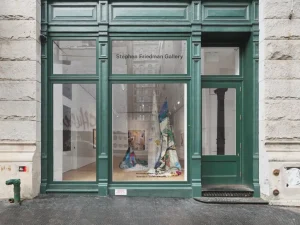Stephen Friedman Gallery will close its New York space at the end of February 2026, drawing a firm line under a two-year experiment that—depending on whom you ask—either represents prudent consolidation or yet another sign that the mid-to-upper gallery sector is buckling under its own contradictions.
There were rumors of Friedman’s decision to leave New York floating around for weeks, but it wasn’t certain until New York critic Jerry Saltz broke the news on Instagram. Not long after, the gallery emailed ARTnews an advance press release, framing the move a “strategic evolution” that allows it to “focus [its] resources” on international activity from a “strong London base.” Friedman cast the retrenchment in almost pastoral terms: a return to home soil, an opportunity to tend to the roots. In the email, the gallery boasted of new directors hired in London, deeper global relationships, and a continued presence on the art-fair circuit, including at Art Basel, Frieze London, Art Basel Miami Beach, and the inaugural Art Basel Qatar next February.
If this all sounds suspiciously upbeat for a gallery closing a space in the world’s largest art market, that’s because it is. “Concluding a program” is one way to put it; backing out of Tribeca less than 30 months after arrival is another.
What the gallery does not say is the obvious thing: that is has become another casualty of 2025. Earlier this month, in a piece titled “Welcome to the era of Art Market Dysmorphia,” journalist Tim Schneider reported in his Substack newsletter The Gray Market that at least 18 dealers have shut down locations or entire operations since January 1. That figure includes outfits across the spectrum, from long-standing mid-tier players to once-ascendant younger galleries. But Schneider also notes that—contrary to the easy doomsday narrative—the same number of galleries have opened new locations or expanded existing ones this year. The mirror image figures make it impossible to claim the market is definitively contracting or expanding. It simply depends on which side of the street you choose to look at.
Stephen Friedman Gallery clearly prefers the sunny side. The gallery’s announcement emphasized institutional accomplishments by artists on its roster—Deborah Roberts at the FLAG Art Foundation in 2026, Jaune Quick-to-See Smith at the Saint Louis Art Museum in 2025, Denzil Forrester at ICA Miami in 2023—as proof that the gallery’s influence in the United States remains intact even without a physical address in New York. It insists its artist list remains unchanged, its international projects uninterrupted.
Still, closing a Tribeca space after two years is not nothing. The New York location opened in October 2023 with a Roberts exhibition and went on to host shows by Anne Rothenstein, Sarah Ball, Forrester, and Andreas Eriksson—serious artists, serious programming, and a significant investment of time and capital. To retreat now suggests an internal calculus that even the gallery’s public optimism can’t quite conceal.
If this year has us taught anything, it’s that the art market’s winners and losers are increasingly indistinguishable from one another. As Schneider argues, the industry is now in an era where galleries can plausibly argue they are expanding even as they contract, and where almost any narrative can be substantiated with enough examples pulled from the chaos. Given the relative opacity of the industry and its financials, it’s hard to argue anything definitively.
Friedman’s statement gestures toward clarity—“areas where we have the greatest impact and flexibility”—but in a year when closures and expansions come in precisely matched pairs, the move reads less like strategy than symmetry. Another gallery exits. Another gallery enters. And everyone, in the meantime is scratching their heads, wondering what will happen next.

